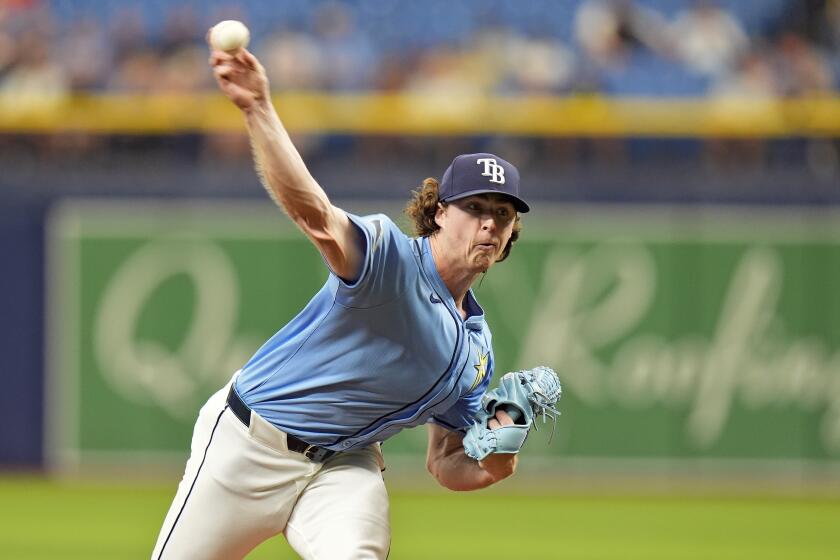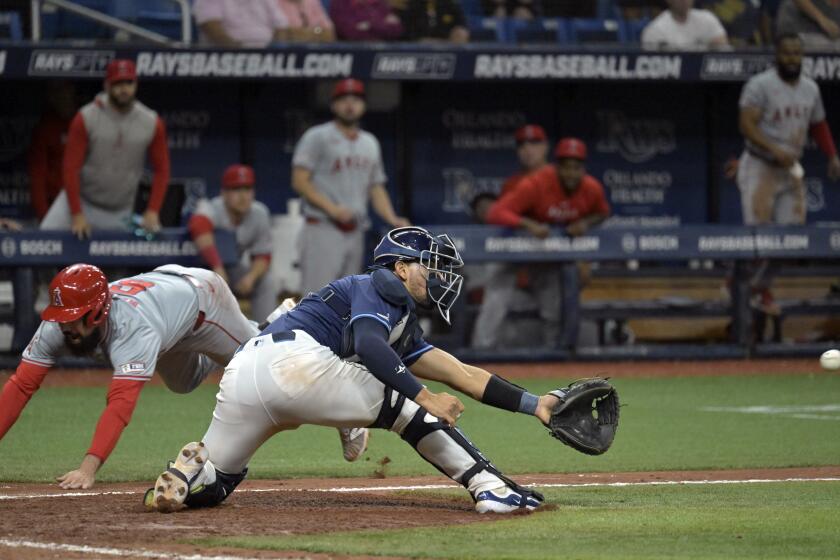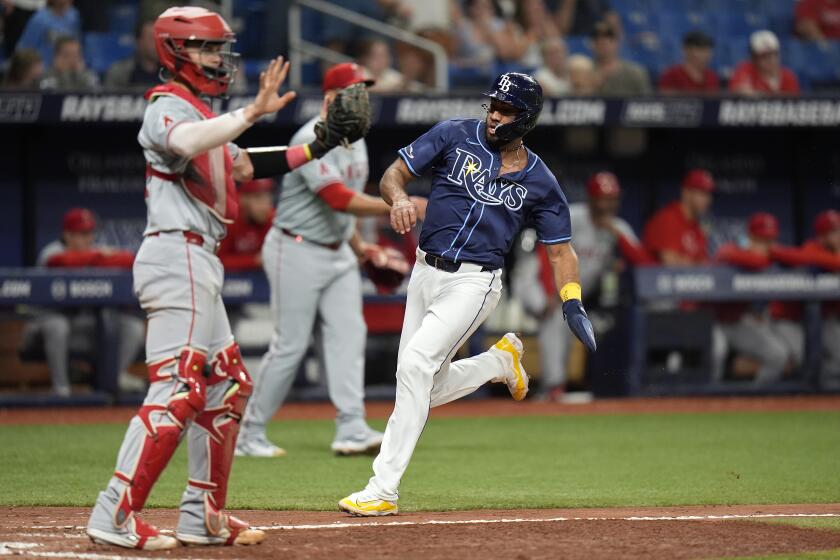Angels’ Albert Pujols nears historic home run mark
It’s an April afternoon in Kansas City, 15 miles from where Albert Pujols graduated high school, 250 miles from where he established himself as the best ballplayer in the first decade of the millennium.
Inside the visiting clubhouse at Kauffman Stadium, couches and chairs separate the expansive room in two. Pujols sits at the end of a row, next to his teenage son, A.J., who’s hanging around the team for the series. Adjacent to A.J. are several Angels, including Mike Trout.
A television suspended from the ceiling shows a game between Pittsburgh and the Chicago Cubs, which Trout and the others watch and comment on between bits of Words with Friends and other distractions on their mobile devices.
Pujols is not watching the game. His headphones in, he’s hoisting a tablet in front of him. It’s playing his highlights as a St. Louis Cardinal, and he’s hammering homer after homer.
“Sometimes, you see him watching video of his at-bats in St. Louis,” Trout said. “It’s just incredible.”
Pujols said he is watching his swing. A teammate suggests there might be other motivations.
“When he watches his video, he watches home runs that he hit,” said Angels closer Bud Norris, who has faced Pujols more than he has any other major leaguer and held him to a .190 average. “He doesn’t watch me punching him out every . . . time.
“. . . He’s implementing positive feedback. He’s remembering how good it felt.”
It must have felt great. At this stage in his career, Pujols is summarily unwilling to discuss the differences between his past and his present. But the statistics speak sufficiently. From 2001 to 2010, he averaged 41 home runs per season, hit .331, got on base 42.6% of the time, and slugged .624. His on-base-plus-slugging percentage was 79 points higher than the next-best player, Alex Rodriguez.
Now Pujols is at the cusp of joining Rodriguez and seven other major leaguers with 600 home runs. Rodriguez joined that exclusive club in August 2010, becoming the youngest player to do it, at 35 years 8 days, before his career was enveloped in a steroid shroud. At 41, he is working as a television analyst.
Pujols, 37, is under contract with the Angels for 4 1/2 more seasons, over which he will be paid about $130 million. The question is, how valuable can he be while his career winds down and his salary rises?
::
He’s implementing positive feedback. He’s remembering how good it felt.
— Angels pitcher Bud Norris
It’s a question that fascinates many people who evaluate ballplayers as a profession. As long as the public has known him, Pujols has been an anomaly. Over 22 months in the early 2000s, he transformed from the 402nd overall pick in the 1999 draft into a superstar.
For the decade that followed, he exhibited no signs of decline and scarcely any variance. Only in his final season in St. Louis was there even an inkling he would be subject to age-related decline along with the rest of the population.
To even take the field regularly at his age qualifies as anomalous. Over the last half-century, only 2% of position players 37 or older have had enough plate appearances in a season to qualify for a batting title. Pujols is attempting to become the fifth player to do that five consecutive times, joining Pete Rose, Craig Biggio, Rickey Henderson and Paul Molitor.
But because of his contract, and the inextricable extent to which the Angels have tied their fortunes to his, Pujols cannot merely survive to be considered a success. He must defy the aging curve’s continued onslaught. To do that, he must stay healthy, a goal that has eluded him in recent seasons.
Pujols has had foot surgery in consecutive winters, twice putting his opening-day readiness in jeopardy. While he made it back each time, his running never recovered, and major league scouts say he’s now one of the slowest players in the sport. Watching him run could be described as painful. It’s a struggle.
His hitting, too, appears affected. This season, Pujols is striking out more than ever before and hitting for less power. He’s on pace to hit 21 home runs, which would approach the career-low 17 he hit in his injury-shortened 99-game 2013 season.
“For me, his body is the key,” said a scout who spoke anonymously because his team does not allow him to comment on opposing players. “Can he keep his lower half healthy? Lower-half injuries make it nearly impossible to hit the way you normally would. His approach and ability to manage the strike zone are still at elite levels and I don’t expect that to change, unless he gets to a point where he loses bat speed, causing him to cheat for fastballs. His swing, though, is short and direct. He can still get to any fastball.”
The scout continued: “The rare times I see him struggle are against guys with good breaking balls that have downward action. Even then, though, you’re not getting him out the same way twice. His body is heavy. To survive the contract, he will need to do something different as far as nutrition and workouts.”
Though he is resting more this season, Pujols and the Angels say there are no plans to reshape the slugger’s body.
“Every day I come here, I look at myself in the mirror and remind myself to give everything that I can of whatever I feel that day,” Pujols said recently. “If I feel 75%, I’ll give 100% of that 75%. If it’s 50%, I’ll give 100% of that 50%. And if it’s 100%, then 110% of that.”
::
He’s never tipping his hat to the pitcher. He gets himself out. That’s why he’s still here.
— Angels pitcher Jesse Chavez
Pujols entered Tuesday’s game hitting .249, his seventh slow start in as many seasons. Yet, every time he makes an out he has the same thought about the opposing pitcher.
“I feel that he just got lucky,” Pujols said, cackling in laughter.
Right-hander Jesse Chavez, who joined the Angels this year after pitching for six other organizations, has never struck out Pujols in 21 plate appearances. He finds him the hardest hitter to face in the major leagues.
In his fifth career start, Chavez, then with Oakland, gave up home run No. 496 to Pujols in 2014, and the pitcher knew immediately. He turned his head to the side in disgust, where he noticed Pujols’ inimitable ogling of his handiwork.
His next time up, Pujols grounded out harmlessly to shortstop, and as he jogged down the line, Chavez sensed the opposite feeling. Chavez had made what he thought was a great pitch, but Pujols was frustrated at himself.
“He’s never tipping his hat to the pitcher. He gets himself out,” Chavez said. “That’s what I’ve learned from him. That’s why he’s still here.”
The Angels are using that feeling for encouragement.
“I don’t think pitchers are beating him,” manager Mike Scioscia said. “He’s always been, historically, a slow starter. You compound that with his spring not being in depth to where you might have wanted it, and you can point to some markers that say, ‘OK, he’s not where he should be.’ But some of the internal things of how hard he’s hitting the ball are markers that are right where you’d expect them to be.”
Scioscia then noted Pujols’ place among the American League’s RBI leaders and asked a reporter to verify his standing. He started Tuesday fifth, with 35, one behind injured teammate Trout.
Scioscia continued: “When you knock in a run, that still carries an enormous amount of weight to what your offense is about. You look at Tony Perez, Edgar Martinez. Historically, there are guys who you didn’t want up there in those situations. Albert’s one of those guys.”
Asked if he believed there was such a thing as having a knack for driving in runs, Scioscia equivocated.
“I think if your process is right and you’re gonna put the ball in play, put it in play hard, and not strike out a lot — and Albert has never had that issue — then you’re gonna have chances to drive in more runs with the power that he has,” he said.
Pujols’ strikeout rate remains less than the league average, but it’s more than 70% higher than his career mark, and nearly 50% higher than last year. Angels hitting coach Dave Hansen said he was unconcerned by that increase.
“I honestly don’t even look at it with him,” Hansen said. “I’m looking at what he’s doing with his RBIs, and trying to keep him in his zone. That’s it.”
::
The topic is taboo around the Angels, but it could be that Pujols is already adjusting to his age and limited mobility. With runners in scoring position, he seems willing to spray balls across the field for singles. But when the bases are clear, he becomes more apt to try for a home run or extra-base hit.
“I think he just wants to do a little too much sometimes, so he’ll take a chance later in a count, maybe where he wouldn’t have before,” Hansen said. “He probably would’ve laid off that pitch knowing he’d walk or get another pitch. That’s the best way I can put it.”
Obstinance helped make Pujols the most feared slugger in the game for a decade, and even in decline he has changed little.
He’s famous for the consistency of his pregame routine, in which he hits off a tee in a cycle from right to left, transitions to hitting soft tosses, then turns on the pitching machine. For 18 seasons, it’s been the same, and the Angels’ batting practice pitcher, Mike Ashman, estimated Pujols still does the same drills 158 games per year.
“It’s not elaborate,” Hansen said. “It’s just focused. The real separator is how committed and focused he is. That’s really the epitome of his career.”
Two days into 2016 spring training, new Angels utilityman Cliff Pennington realized he had watched Pujols complete the same hitting exercises both mornings.
“And you’re like, ‘Well, maybe that’s why he’s so good,’” Pennington said. “And then he does the same thing the third day, the fourth day. It’s still the same. He’s so good at doing it every single day that it almost seems mechanical. Only a computer could repeat itself every single day. We’re all human. We all think, ‘Maybe I’ll try this.’ But he doesn’t do that. He just goes on.”
He has, and he will. Seven hundred home runs are within Pujols’ grasp, as are 3,000 hits — he started Tuesday 121 shy. More imminent is 610 home runs, which would vault him ahead of fellow Dominican Sammy Sosa for the most by a Latin American-born player. As 600 nears, Pujols has declined to speak about its significance.
“I don’t want to talk about that yet,” he said recently. “I promise you, after it happens, we can talk all about it. I just don’t want to right now.”
Trout said he did not think Pujols paid attention to milestones until they occurred.
“Them round numbers,” Trout said. “They get you.”
Indications are otherwise. In March, as NBA star Russell Westbrook neared his own milestone of averaging a triple-double in a season, Pujols kept abreast. Two of the Angels’ most fervent basketball fans, pitchers Garrett Richards and Andrew Heaney, hail from Oklahoma and are fans of Westbrook’s team, the Oklahoma City Thunder. When they talked up their superstar, Pujols engaged in smack talk, noting that Westbrook was also approaching another ignominious marker: 400 turnovers.
Pujols’ sentimentality seems to vary. Plenty of young players relay stories about his kind words to them. After starting pitcher Alex Meyer’s second outing with the Angels last season, Pujols privately suggested to him to look into the possibility he had been tipping his curveball. The next afternoon, Pujols watched the video himself and told the pitcher it was a false alarm.
Then there are stories like Norris’ first major league hit. In his first career start, he faced the Cardinals at Busch Stadium and beat out an infield single. When he got back to first base, Pujols showed him the baseball with a quizzical look on his face.
“Do you really want this?” he asked Norris.
In April 2014, Pujols hit his 499th and 500th home runs in the same game, at Washington. He told reporters later that night he felt something “special” during batting practice. Upon returning home from a nine-game trip, he fielded the same assortment of questions from local reporters he did back East.
They asked, generally, how it felt to occupy such rarefied air, and Pujols said what he typically says: that he was honored to be among such greats, but that he hadn’t yet contextualized his own achievements and would do so only upon the end of his career.
“That’s for you guys to talk about, not me,” he said.
At that, he opened a top cabinet in his locker, grabbed a gold necklace with the numbers 5-0-0 dangling from the chain, tucked it around his head, and walked out of the Angels clubhouse.
pedro.moura@latimes.com
Twitter: @pedromoura
More to Read
Go beyond the scoreboard
Get the latest on L.A.'s teams in the daily Sports Report newsletter.
You may occasionally receive promotional content from the Los Angeles Times.







